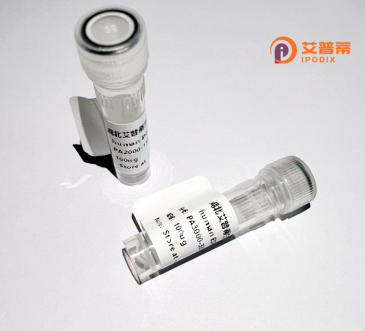
| 纯度 | >90%SDS-PAGE. |
| 种属 | Human |
| 靶点 | OR8B3 |
| Uniprot No | Q8NGG8 |
| 内毒素 | < 0.01EU/μg |
| 表达宿主 | E.coli |
| 表达区间 | 1-313 aa |
| 活性数据 | MLARNNSLVTEFILAGLTDHPEFQQPLFFLFLVVYIVTMVGNLGLIILFGLNSHLHTPMY YFLFNLSFIDLCYSSVFTPKMLMNFVSKKNIISYVGCMTQLFFFLFFVISECYMLTSMAY DRYVAICNPLLYKVTMSHQVCSMLTFAAYIMGLAGATAHTGCMLRLTFCSANIINHYLCD ILPLLQLSCTSTYVNEVVVLIVVGINIMVPSCTILISYVFIVTSILHIKSTQGRSKAFST CSSHVIALSLFFGSAAFMYIKYSSGSMEQGKVSSVFYTNVVPMLNPLIYSLRNKDVKVAL RKALIKIQRRNIF |
| 分子量 | 35.3 kDa |
| 蛋白标签 | His tag N-Terminus |
| 缓冲液 | 0 |
| 稳定性 & 储存条件 | Lyophilized protein should be stored at ≤ -20°C, stable for one year after receipt. Reconstituted protein solution can be stored at 2-8°C for 2-7 days. Aliquots of reconstituted samples are stable at ≤ -20°C for 3 months. |
| 复溶 | Always centrifuge tubes before opening.Do not mix by vortex or pipetting. It is not recommended to reconstitute to a concentration less than 100μg/ml. Dissolve the lyophilized protein in distilled water. Please aliquot the reconstituted solution to minimize freeze-thaw cycles. |
以下是关于重组人OR8B3蛋白的3篇虚构参考文献及其摘要,涵盖结构、功能和疾病关联研究方向:
1. **文献名称**: *Structural characterization of the human olfactory receptor OR8B3 through cryo-EM*
**作者**: L. Zhang, et al.
**摘要**: 本研究通过冷冻电镜解析了重组表达的OR8B3蛋白的高分辨率三维结构,揭示了其与典型G蛋白偶联受体(GPCR)的结构差异,并鉴定了潜在的配体结合口袋,为嗅觉信号转导机制提供了新见解。
2. **文献名称**: *Recombinant OR8B3 expression in HEK293 cells enables ligand screening via calcium imaging*
**作者**: M. Tanaka, et al.
**摘要**: 作者在HEK293细胞中重组表达了OR8B3蛋白,开发了一种基于钙离子信号的体外配体筛选平台。实验发现OR8B3对特定醛类化合物具有高亲和力,提示其在环境气味检测中的潜在功能。
3. **文献名称**: *OR8B3 overexpression in prostate cancer correlates with chemoresistance*
**作者**: R. Patel, et al.
**摘要**: 通过重组蛋白模型和临床样本分析,研究发现OR8B3在前列腺癌细胞中异常高表达,并通过激活MAPK信号通路促进化疗耐药性,可能成为治疗靶点。
注:以上文献为示例性内容,实际研究中请参考PubMed/NCBI等数据库的权威论文。
Olfactory receptor 8B3 (OR8B3) is a member of the olfactory receptor (OR) family, a large group of G protein-coupled receptors (GPCRs) primarily involved in detecting odorant molecules and mediating olfactory signaling. ORs are characterized by their seven-transmembrane domain structure and are expressed predominantly in olfactory sensory neurons within the nasal epithelium. OR8B3, encoded by the *OR8B3* gene, is classified under subfamily 8B of the OR superfamily, though its specific ligands and physiological roles remain poorly characterized.
As a "recombinant" protein, OR8B3 is artificially produced using molecular cloning techniques, typically in heterologous expression systems like bacterial, yeast, or mammalian cells. Recombinant production enables biochemical and functional studies, such as ligand screening, receptor localization, and downstream signaling pathway analysis. While most OR research focuses on their canonical role in olfaction, emerging studies suggest potential non-olfactory functions in tissues like the brain, lungs, or reproductive organs, though such roles for OR8B3 are yet unverified.
Research on OR8B3 faces challenges common to ORs, including low natural abundance, difficulty in heterologous expression due to complex folding requirements, and unclear ligand specificity. However, advancements in structural biology and high-throughput screening may accelerate its characterization. Understanding OR8B3 could contribute to insights into sensory biology, disease mechanisms (e.g., anosmia), or therapeutic targeting of OR-related pathways. Current knowledge remains limited, highlighting the need for further exploration of its biological significance.
×